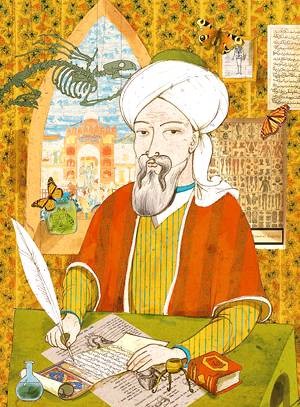Canon Of Medicine Ibn Sina Pdf
The Canon of Medicine (Arabic. Is an encyclopedia of medicine in five books compiled by Persian philosopher Avicenna (Ibn Sina) and completed in 1025. Unani Tibb Greek Medicine Avicenna Canon of medicine. See more of Unani Tibb Greek Medicine Avicenna Canon of. The Ibn Sina Institute of Tibb is. Avicenna canon of medicine pdf. Is the most famous scientific work by Ibn Sina. Avicenna Canon of Medicine Volume 2, Natural Pharmaceuticals. Excerpts from Ibn Sina’s Canon of Medicine in Arabic and Latin. The Canon of Medicine, or Al-Qanun fī al-Tibb, is the most famous scientific.


In his Al Hammadi Lecture at the Royal College of Physicians of Edinburgh, John Urquhart (2006), professor of biopharmaceutical sciences at the University of California at San Francisco, contrasted Ibn Sina’s Canon of Medicine (c. 1012) with Osler’s Principles and Practice of Medicine (Osler 1892). Urquhart asked himself which of the two books he would want if he was marooned and in need of a guide for practical medicine. He opted for Ibn Sina’s Canon because the book presents an integrated view of surgery and medicine. Ibn Sina tells his readers, for example, how to judge the margin of healthy tissue to remove with an amputation.
In contrast, Osler shunned intervention in his Principles and Practice of Medicine. Windows 8.1 2015 Enterprise Activator on this page. The enduring respect in the 21st century for a book written a millennium earlier is testimony to Ibn Sina’s achievement. Abu Ali al-Husayn ibn Abd Allah ibn Sina (known as Avicenna in Europe) was born about 980 CE (370 H), near Bukhara, where his family moved soon after his birth (Mahdi et al. 1987). Bukhara had been for centuries the glory of the Persian Empire, but the empire was falling apart into smaller kingdoms under the pressure of Arab invasions. This was one of the reasons that Ibn Sina had to move several times during his life. Despite this, he managed to write several outstanding books, which went on to influence the concepts and principles of scholars for centuries.
Ibn Sina’s studies began in Bukhara under the guidance of several well-known scholars of the time, for example, Abu Abd Allah al-Natili. He studied logic, philosophy, metaphysics, and natural sciences, and gradually developed an interest in medicine. His knowledge soon began to exceed that of his teachers. Ibn Sina began writing his major medical composition, ( Canon of Medicine) in Jorjan (also written as Gorgan), at the southeast corner of the Caspian Sea, and continued its composition in Rayy, an important medieval city south of modern Tehran, where two other great medical writers in Arabic, al-Razi and Ibn Hindu, were born (; ). The Canon was completed in Hamadan even further southwest, where Ibn Sina died in 1037 CE (428 H). Ibn Sina had intended to include his clinical casenotes in the book, but the paper on which they were written was lost before he was able to do so (Pormann and Savage-Smith 2006, p 117-118). The most celebrated medical book prior to the publication of Ibn Sina’s Canon was the Complete Book of the Medical Art (Kitab Kamil al-sina`ah al-tibbiyyah) composed about 983 by Ali ibn al-Abbas al-Majusi. Although the Syrian physician Ibn al-Ibri (known as Bar Hebraeus), who died in 1286, judged this book to include more practical clinical advice than the Canon, he records that publication of the latter soon eclipsed memory of the former (Elgood 1951, p 195).
Indeed, Ibn Sina’s Canon remained the most popular medical textbook in the world over the subsequent six centuries (Siraisi 1987). Ibn Sina divided his Canon of Medicine into five books (Savage-Smith 1996). The first book – the only one to have been translated into English (Gruner 1930; Shah 1966) – concerns basic medical and physiological principles as well as anatomy, regimen, and general therapeutic procedures. The second book is on medical substances, arranged alphabetically, following an essay on their general properties. The third book concerns the diagnosis and treatment of diseases specific to one part of the body, while the fourth covers conditions not specific to one bodily part, such as poisonous bites and obesity. The final, fifth, book is a formulary of compound remedies. Adobe Flash Player For Xubuntu here.
The images of Ibn Sina’s text shown in The James Lind Library are taken from an edition of his book published in Rome in 1593, part of the historic collection of the Sibbald Library of the Royal College of Physicians of Edinburgh. This version of the book was based on a Florentine manuscript, and it is the first medical work to have been printed in Arabic. One of us (AT) translated the passages quoted from the Arabic text. Medicine is a science from which one learns the conditions of the human body with regard to health and the absence of health, the aim being to protect health when it exists and restore it when absent. Then, after that famous opening sentence, Ibn Sina continues: Someone might say to us that medicine is divided into theoretical and practical parts and that, by calling it a science, we have considered it as being all theoretical. To this we respond by saying that some arts and philosophy have theoretical and practical parts, and medicine, too, has its theoretical and practical parts.